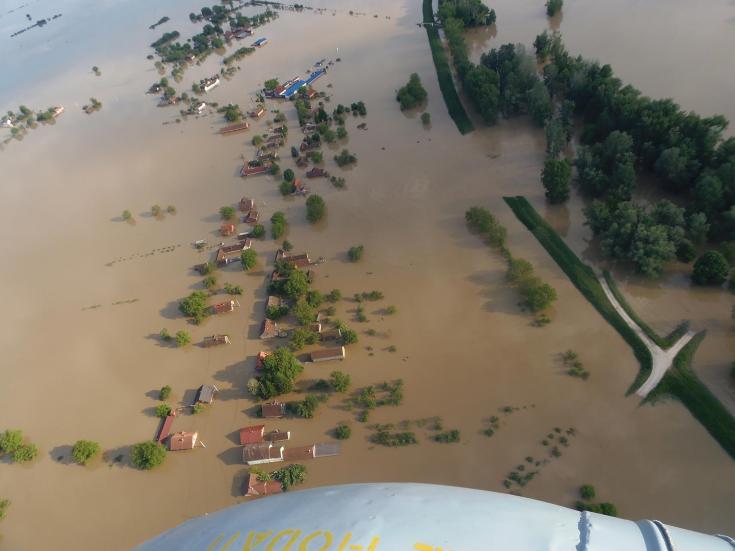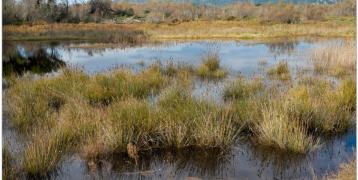Flood prevention and damage restoration

In Europe, floods affect more people and are more costly than any other natural hazard. Due to climate change and longer periods of drought, the frequency of floods is increasing and is still expected to rise in the coming decade. However, with proper management, the impact and likelihood of floods can be reduced. Integrated flood risk management goes hand in hand with nature protection and restoration.
The Dutch way
Undoubtedly, regions and local communities need to develop climate adaptation strategies and take urgent action to better protect their citizens and infrastructure from the rapidly growing climate risks. The Netherlands, renowned for its massive storm barriers, dikes and canals can provide several examples of such measures. In addition to their ingenious engineering solutions, the Dutch are also implementing new ideas and approaches. To increase the permeability of soils and retain more ground water, for instance, they have introduced a competition to remove concrete tiles from private gardens and replace them with plants and greenery. Since 2021, more than 9.4 million tiles have been replaced all over the Netherlands and the competition is still going strong.
The second example comes from Delft where the Delfland Water Authority manages an area of intensive greenhouse agriculture (3705 ha). To prevent flooding, the water authority introduced the Rainlevelr project, a collaboration between greenhouse horticulture entrepreneurs and the water board. The clever management system uses the greenhouses’ collective rainwater storage space as a precaution against heavy rainfall. When the forecast shows heavy rains, greenhouse owners are required to discharge a small amount of water into nearby ditches before the downpour occurs. This creates more storage space for rainwater at the greenhouses and reduces the stress on the water management system and the risk of flooding.
Flood damage restoration
Sometimes flood protection measures implemented in the past do not withstand the pressure of floods today. Interreg Europe project NBS4LOCAL has identified a good practice realised between Croatia and Serbia, which has aimed at the restoration of flood damage in the Spačva-Bosut forest watershed area and the establishing of a cross-border preventive system.
The “Forest Flow” project was initiated as a result of the flood disaster that Croatia and Serbia suffered in May 2014. Since natural watercourses and existing drainage systems did not have the capacity to convey excess water, the consequences of heavy rainfall were devastating, and the effects on the economy, environment, and people in the flooded area are still felt to this day.
Croatian Forestry, one of the responsible parties in the Forest Flow project, has a long history (over 200 years) of governing forests with the use of nature-based solutions. “We have always tried to be as close to nature as possible, for us it is the normal thing to do,” explains Danijel Cestarić, Assistant Manager at Croatian Forestry.
By implementing the project, flood protection infrastructure was restored through renovated canals and access roads on both sides of the river, in order to improve forests’ ability to absorb floodwater. Access for flood-fighting emergency actions was also provided. “The canals are now properly maintained and the place is much more resilient than before,” adds Cestarić.
Boosting local wildlife population
Because the floods caused severe wildlife loss (especially red deer and roe deer; 258 deer were directly killed by floods), the deer population needed to be revived, and shelters, observation points, feeders, and watering holes were built to facilitate the successful return of wildlife to the forest. “42 deer were introduced on the Croatian side and 36 on the Serbian side. They have had many offspring since,” says Cestarić.
After adapting to the new habitat, deer movement is now being monitored using telemetry collars and field observations to manage their population. According to Cestarić, procuring the deer actually turned out to be one of the project’s toughest obstacles. “We couldn’t buy the deer because of a lack of farms that could supply the animals, as well as some legal issues on the Serbian side. Overall, it took around six to twelve months”.

Cross-border collaboration
Cross-border cooperation, intervention teams, and flood defence plans were established for more efficient flood defence, along with educating students in six primary and two secondary forestry schools on both sides of the border. “Cross-border communication was non-existent because of the war, so the project brought together a network of stakeholders from both countries. We have established a very good collaboration and a consortium (consisting mainly of forest and water management bodies),” says Cestarić. While this consortium was built for the project, it still continues to cooperate and exchange information pertaining to river management, wildlife, diseases, forest management and other topics.
Cestarić believes that it is very hard to say what to do in these turbulent times of climate change. “The problem is that we are facing extreme weather events – droughts, floods and storms are all more severe than in the past. If you have the opportunity, release water to the forest during high peaks of water, use natural canals, maintain the embankments, plant species around the river that are able to survive submerged for some period of time. We are, for example, using the Slavonian Oak, which is a native species for this area.”
Following the catastrophic floods that occurred in May 2014 in Croatia and Serbia, the damaged area of the Spačva-Bosut forest basin has been restored. Through all the project activities, the biodiversity of this ecologically valuable area has been preserved.
To continue exploring the topic, you can also have a look at the good practice Forest flow – flood damage repair, as well as the resources below.





